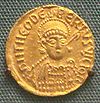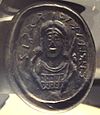- Merovech
-
 Silvered brass mounting from 1867 depicting Merovech victorious in battle, by Emmanuel Frémiet.
Silvered brass mounting from 1867 depicting Merovech victorious in battle, by Emmanuel Frémiet.
Merovech (Latin: Meroveus or Merovius) is the semi-legendary founder of the Merovingian dynasty of the Salian Franks (although Chlodio may in fact be the founder), which later became the dominant Frankish tribe. He allegedly lived in the first half of the fifth century. His name is a Latinization of a form close to the Old High German given name Marwig, lit. "famed fight" (cf. māri "famous" + wīg "fight") compare modern Dutch mare "renowned" and vecht "fight".[1] The first Frankish royal dynasty called themselves Merovingians ("descendants of Meroveus") after him.
There is little information about him in the later histories of the Franks. Gregory of Tours only names him once as the father of Childeric I while putting doubt on his descent from Chlodio.[2] Many admit today that this formulation finds its explanation in a legend reported by Fredegar.[3] The Chronicle of Fredegar interpolated on this reference by Gregory by adding Merovech was the son of the queen, Chlodio's wife; but his father was a sea-god, bistea Neptuni.[4] No other historical evidence exists that Merovech ever lived. Some researchers have noted that Merovech, the Frankish chieftain, may have been the namesake of a certain god or demigod honored by the Franks prior to their conversion to Christianity. It has been suggested Merovech refers to or is reminiscent to the Dutch river Merwede,[5] nowadays part of the Rhine-Meus-Scheldt delta but historically a main subsidiary of the Rhine, in the area where, according to Roman historians, the Salian Franks once dwelled. Another theory[6] considers this legend to be the creation of a mythological past needed to back up the fast-rising Frankish rule in Western Europe.
According to another legend, Merovech was conceived when Pharamond's wife encountered a Quinotaur, a sea monster which could change shapes, while swimming. Though never stated, it is implied that she was impregnated by it. This legend was related by Fredegar in the seventh century and may have been known earlier. The legend is probably a back-formation or folk etymology used to explain the Salian Franks' origin as a sea coast dwelling people and was based on the name itself. The "Mero-" or "Mer-" element in the name suggests a sea or ocean (see Old English "mere," Latin "mare," or even the Modern English word "mermaid", etc.). The "Salian" in "Salian Franks" may be a reference to salt, a reminder of their pre-migration home on the shores of the North Sea (alternatively, it may refer to the Isala or IJssel river behind which their homeland, the Salland, may have been located). The legend could also be explained in a much easier way. The sea monster could have been a foreign conqueror, coming from the sea, taking the dead king's (Chlodio or Pharamond) wife to legitimise his rule.
Contents
Reference in popular culture
The legend about Merovech's conception was adapted in 1982 by authors Henry Lincoln and Richard Leigh in their book Holy Blood Holy Grail, as the seed of a new idea. They hypothesized that this "descended from a fish" legend was actually referring to the concept that the Merovingian line had married into the bloodline of Jesus Christ, since the symbol for early Christians had also been a fish. This theory, with no other basis than Lincoln and Leigh's hypothesis, was further popularized in 2003 via Dan Brown's bestselling novel, The Da Vinci Code.[7][8]
There is also a fictional character called The Merovingian in the movies The Matrix Reloaded and The Matrix Revolutions (portrayed by Lambert Wilson). The character is modeled as an ancient and powerful leader of exiles. He also has extensive knowledge of the inner workings of the universe and uses this knowledge to support his decadent lifestyle.
See also
Notes
- ^ Green, D.H. Language and History in the Early Germanic World. Cambridge, England: Cambridge University Press, 1998.
- ^ Gregory of Tours - The History of the Franks, II.9
- ^ Christian Settipani - Addenda to Les Ancêtres de Charlemagne, 1990 [1]
- ^ Pseudo-Fredegar, Hist. III, 9
- ^ Emil Rückert: Oberon von Mons und die Pipine von Nivella; Weidmann'sche Buchhandlung, Leipzig, Germany, 1836
- ^ see M. Todd's, The Early Germans
- ^ Behind the Da Vinci Code, 2006, History Channel documentary about Henry Lincoln
- ^ Holy Blood Holy Grail, Michael Baigent, Richard Leigh, Henry Lincoln, 1982
References
- Behind the Da Vinci Code, 2006, History Channel documentary about Henry Lincoln
- Todd, M. The Early Germans
- Wood, Ian. The Merovingian Kingdoms 450–751. London: Longman Group, 1994.
External links
Merovingian monarchs Childeric I (457–481) • Clovis I (481–511) • Childebert I (511–558) • Chlodomer (511–524) • Theuderic I (511–533) • Theudebert I (533–548) • Theudebald (548–555) • Chlothar I the Old (511–561) • Charibert I (561–567) • Guntram (561–592) • Sigebert I (561–575) • Childebert II (575–595) • Theudebert II (595–612) • Theuderic II (612–613) • Sigebert II (613) • Chilperic I (561–584) • Chlothar II the Great (584–623) • Dagobert I (623–634) • Charibert II (629–632) • Chilperic (632) • Sigebert III (634–656) • Childebert the Adopted (656–661) • Clovis II (639–657) • Chlothar III (657–673) • Childeric II (662–675) • Theuderic III (675–691) • Dagobert II (675–679) • Clovis IV (691–695) • Childebert III the Just (695–711) • Dagobert III (711–715) • Chilperic II (715–721) • Chlothar IV (717–720) • Theuderic IV (721–737) • Childeric III (743–751)Categories:- Merovingian dynasty
- Frankish kings
- 5th-century monarchs in Europe
Wikimedia Foundation. 2010.


